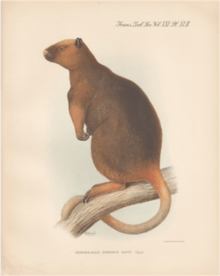Wondiwoi tree-kangaroo
| Wondiwoi tree-kangaroo | |
|---|---|
 | |
| Illustration from the 1936 Rothschild and Dollman monograph 'The Genus Dendrolagus' | |
| Scientific classification | |
| Kingdom: | Animalia |
| Phylum: | Chordata |
| Class: | Mammalia |
| Infraclass: | Marsupialia |
| Order: | Diprotodontia |
| Family: | Macropodidae |
| Genus: | Dendrolagus |
| Species: | D. mayri |
| Binomial name | |
| Dendrolagus mayri | |
The Wondiwoi tree-kangaroo (Dendrolagus mayri) is a mammal species in the genus Dendrolagus. It was known until recently from a single specimen which was collected in 1928.[3] The only known specimen is a male weighing 9.25 kilograms (20.4 lb).[3] D. mayri was located in the Wondiwoi Peninsula of West Papua at an elevation of 1,600 metres (5,200 ft) within montane forest. It is thought that the Wondiwoi tree-kangaroo could occupy an area of 300 square kilometres (120 sq mi).[3] Global Wildlife Conservation, the wildlife conservation charity, lists the Wondiwoi Tree Kangaroo as one of their "25 Most Wanted Lost Species".[4]
Taxonomy
It was named in honour of Ernst Mayr, who collected the type specimen now deposited in the Natural History Museum, London.[2] It was described by Lord Rothschild and Capt. Guy Dollman in a 1933 paper[5] and an illustration based on the only known specimen was published in their 1936 monograph on the genus.[6]
Discovery
In July 2018,[7] what may prove to be the first ever photographs of the species were taken by British naturalist Michael Smith.[8][9][10] Smith was investigating Vireya rhododendrons in an unexplored area of the Wondiwoi ranges and photographed a 'dorianus type' tree kangaroo at an altitude of approximately 1,600 metres. Scent marks, tree kangaroo scat and claw marks at the base of trees made by climbing tree kangaroos were found from 1,700m to 2,000m in steep montane forest. Local hunters, who frequently kill Grizzled tree kangaroos in lowland forest, rarely if ever visit the forest above 1,500m because of the difficult terrain, lack of water sources and dense bamboo thickets.
Australian zoologist and conservationist Tim Flannery, who described four species or subspecies of tree kangaroo including the Dingiso, was reported as saying "Everything in the pictures is consistent with the only known specimen. It is an extremely significant find, the least known of tree roos and almost the most poorly known macropodid. To find it existing in good numbers in 2018 is astonishing." "I was amazed when I saw the photos. I had spoken to Ernst Mayr, the collector of the only previously known specimen, but could get little additional information. I believe it has gone unspotted for so long because it's restricted to a single, small mountain range."[8]
Status
Long thought to be extinct or critically endangered,[11] the IUCN Red List listed the species as Critically Endangered (Possibly Extinct) because "if the species still exists the population must be very small (less than 50 mature individuals) and probably in decline due to hunting pressures. Although the area has not been well-sampled, there have been a few visits to the area with no reports of this species."[12]
The species status of Dendrolagus mayri is uncertain. Some authorities refer to all 'dorianus type' tree kangaroos as subspecies of Doria's tree kangaroo, including Colin Groves, who published a major revision of the taxonomy of the genus in 1982.[13] More recent DNA analysis indicates, however, that the members of the dorianus group deserve species status, although Dendrolagus mayri itself was not included in the study.[14]
References
- ↑ Leary, T., Seri, L., Flannery, T., Wright, D., Hamilton, S, Helgen, K., Singadan, R., Menzies, J., Allison, A. & James, R. 2016. Dendrolagus mayri. The IUCN Red List of Threatened Species 2016: e.T136668A21956785. https://dx.doi.org/10.2305/IUCN.UK.2016-2.RLTS.T136668A21956785.en. Downloaded on 31 July 2018.
- 1 2 Rothschild, Walter; Dollman, Guy (31 March 1933). Hill, J.P., ed. "Exhibitions and Notices". Journal of Zoology. 103 (2): 540–541. doi:10.1111/j.1096-3642.1933.tb01607.x.
- 1 2 3 "Tenkile Wondiwoi Tree Kangaroo". Tenkile Conservation Alliance.
- ↑ Global Wildlife Conservation. Lost Species Most Wanted Lost Species https://www.lostspecies.org/ Most Wanted Lost Species Check
|url=value (help). Missing or empty|title=(help) - ↑ Rothschild, W. (1933). "A new tree-kangaroo from the Wondiwoi Mountains, Dutch New Guinea". Proceedings of the Zoological Society of London: 40.
- ↑ Rothschild, W. (March 1936). "The Genus Dendrolagus". Proceedings of the Zoological Society of London. 21 (6): 477–549. doi:10.1111/j.1096-3642.1936.tb00459.x.
- ↑ Solly, Meilan (2018-09-27). "Elusive Tree Kangaroo Spotted for First Time in 90 Years". Smithsonian. Retrieved 2018-09-28.
- 1 2 Mail on Sunday, 19 August 2018
- ↑ Pickrell, John (25 September 2018). "Rare Tree Kangaroo Reappears After Vanishing for 90 Years". National Geographic. Retrieved 2018-09-28.
- ↑ "Peek-a-roo! Farnham man finds 'extinct' tree kangaroo". Alton Post Gazette.
- ↑ "Wondiwoi Tree Kangaroo". www.tenkile.com. Retrieved 2018-08-22.
- ↑ "Dendrolagus mayri (Wondiwoi Tree-kangaroo)". www.iucnredlist.org. Retrieved 2018-08-22.
- ↑ Groves, Colin P. (1982). "The Systematics of Tree Kangaroos (Dendrolagus; Marsupialia, Macropodidae)". Aust. Mammal. 5: 157–86.
- ↑ Eldridge, Mark D. B. (2018). "Phylogenetic analysis of the tree-kangaroos (Dendrolagus) reveals multiple divergent lineages within New Guinea". Molecular Phylogenetics and Evolution. 127: 589–599. doi:10.1016/j.ympev.2018.05.030. PMID 29807156.
